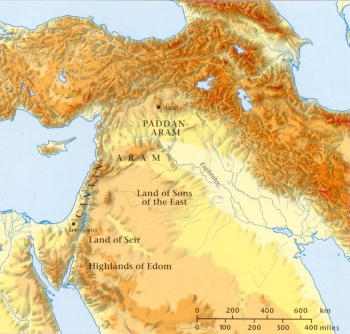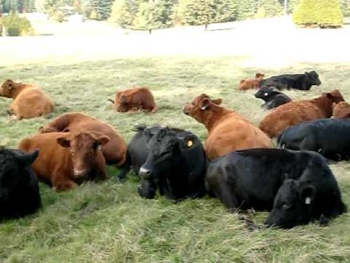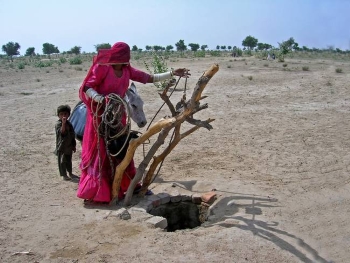wa-Yeitzei 1st Eve (Mo•tzâ•eiꞋ Shab•âtꞋ Beginning Week)
Ya•a•qovꞋ Leaves For Khâ•rânꞋ
To Find A Wife From Uncle Lâ•vânꞋ's Family

 |
 |
With his elder twin brother, Ei•sauꞋ, threatening to kill him, Ya•a•qovꞋ left Bᵊeir ShëvꞋa, heading toward Khâ•rânꞋ to live with his uncle, Lâ•vânꞋ, and look for a wife from among his cousins who shared the family religious values and views of his grandfather, Avᵊrâ•hâmꞋ, and his father, Yi•tzᵊkhâqꞋ.
Su•lamꞋ Ya•a•qovꞋ
 England 350x214.jpg) |
When he arrived ba-Mâ•qōmꞋ, he spent the night there, because the sun was setting. So he took some stones1 of ha-Mâ•qōmꞋ and placed them as a windbreak and barrier to predators around his head2 and lay down ba-Mâ•qōmꞋ.
Then he dreamed: Look, a su•lamꞋ was positioned with its head in the heavens, stretching earthward. And look, ma•lâkh•eiꞋ Ël•oh•imꞋ ascending, then descending by it. And look, ä' was positioned over it saying,
 fm N 0350x263.jpg) |
"I am ä', the Ël•oh•eiꞋ of Avᵊrâ•hâmꞋ, your patriarch; and the Ël•oh•eiꞋ of Yi•tzᵊkhâqꞋ. Hâ-ârꞋëtz upon which you're laying shall I give to you and your descendants. Your descendants shall be like the dust of hâ-ârꞋëtz. You shall spread seaward, eastward, northward and southward. And by you, and by your descendants, shall all of the families of ha-a•dâm•âhꞋ be blessed."
So look, I'm with you and will watchguard over you wherever you go; and I will bring you home again to this ha-a•dâm•âhꞋ. For I will not abandon you until I've done what I spoke of.
, Ai, Psagot (Jebel et-Tawil) 350x268.jpg) |
Then Ya•a•qovꞋ awoke out of his sleep thinking, "Therefore, ä' is ba-Mâ•qōmꞋ and, by Myself, I didn't realize it!" So he was terrified, saying, "How awesome ha-Mâ•qōmꞋ is! There's nothing else here unless this is Beit Ël•oh•imꞋ—and this is ShaꞋar ha-shâ•maꞋyim!"
When Ya•a•qovꞋ got up the next morning, he took the main windbreaker stone, stood it on-end for a monument, poured shëꞋmën zaꞋyit on top and called ha-Mâ•qōmꞋ "Beit Eil" 3 instead of the original name (Luz City).
 350x158.jpg) |
Then Ya•a•qovꞋ made a solemn vow, saying, "If Ël•oh•imꞋ will be with me and watchguard over me in this dërꞋëkh that I'm going by myself, granting me bread to eat and clothes to wear so that I return in peace to my father's house, then ä' shall be my Ël•oh•imꞋ—and this stone that I have stood upright for a monument shall become a Beit Ël•oh•imꞋ. And of everything You give me, I will absolutely apportion a tenth to You."
Ya•a•qovꞋ Arrives In Khâ•rânꞋ
Meets His Future 2nd Wife: Râ•kheilꞋ
 |
So Ya•a•qovꞋ put one foot after the other, slogging along north leg of his journey toward the sons of the East.
In early-afternoon of the last day of his journey, as he approached the outskirts of Khâ•rânꞋ in the distance, he looked and, over there! He speckled three tzon of tzon resting in a field with their haunches tucked under them, around the local bᵊeir waiting to be watered. But the covering stone over the mouth of the bᵊeir was too big for only 3 herdsmen to move.
 |
The local bᵊeir is where all of the local tzon accumulated in late afternoons for water. Several of the local herdsmen would roll the stone off of the mouth of the bᵊeir. Strong young (usually single) women congregated at the local bᵊeir in the late afternoons to fetch water for their family's daily needs, which they hauled up by rope in a waterskin and poured into a pottery jug to carry home on their shoulders. Then the herdsmen would draw water and pour it in troughs for their tzon. After watering their tzon, they would roll the stone back onto its place, covering the mouth of the bᵊeir, to protect their precious water supply, essential for their survival, from animals and debris.
So Ya•a•qovꞋ hailed them: "Where are you from, my brothers?"
"We're from Khâ•rânꞋ," they yelled back.
When Ya•a•qovꞋ neared within conversational distance, he asked them, "Do you know Lâ•vânꞋ Bën-NâkhōrꞋ?"
"Yeah, we know him," they replied.
"How's he doing?" Ya•a•qovꞋ inquired.
"He's doing great," the herdsmen replied. "Look," they added, "there's his daughter, Râ•kheilꞋ now, in the distance, bringing his tzon to water."
"What's wrong?" Ya•a•qovꞋ asked, "There's still a lot of daylight left. It's too early for livestock to be brought in from the pasture. Aren't you going to water the tzon and take them back out to graze for the rest of the afternoon?"
Pointing at the bᵊeir, they answered, "We can't water our tzon until enough herdsmen arrive to move that big stone from the mouth of the bᵊeir."
Before he had finished speaking, Râ•kheilꞋ arrived at the bᵊeir with her father's tzon, for she was a herdswoman.
When Ya•a•qovꞋ saw Râ•kheilꞋ Bat-Lâ•vânꞋ, his maternal uncle with the tzon of his maternal uncle, he went over to the bᵊeir, rolled the stone off of the mouth of the bᵊeir and ya•shᵊqᵊ4 the tzon of his maternal uncle.
Then Ya•a•qovꞋ yi•shaqꞋ5 Râ•kheilꞋ, raised his voice and, sobbing, related to her that her father, Lâ•vânꞋ, was his maternal uncle6—that he was Ya•a•qovꞋ, Bën RiꞋvᵊq•âh (her paternal aunt)! Then she ran and related it to her father.
When Lâ•vânꞋ heard the report of Ya•a•qovꞋ, his nephew, he ran to him, hugged him with the conventional Middle Eastern kiss and brought him home with him, where Ya•a•qovꞋ recounted all of these things. Then Lâ•vânꞋ said to him, "Indeed, you are my bone and flesh." So Ya•a•qovꞋ stayed with Lâ•vânꞋ for a month.

Optional parental preparation:
- Note 1 – îÅàÇáÀðÅé

- Note 2 – îÀøÇàÂùÑÉúÈéå – Nobody uses a stone for a pillow!

- Note 3 – Beit Eil (Hellenized to "Bethel") — No evidence or other proof of any kind locates Biblical Beit Eil prior to 5th century C.E. "church fathers"—upon whom modern archeologists artfully, and most unscientifically, relied. Scripture plus topography suggests that Beit Eil is most likely located beneath modern Arab-occupied al-Bireh (not nearby Beitin, assumed by most modern archeologists and maps—which contradicts a number of facts noted in sources below), a northeast suburb of Ramallah, just north of Yᵊru•shâ•laꞋyim. The Bible is right. The facts are right. The dates are right. It's archeologists' assumed locations, and relying on post-135 C.E. Christian sources, that are often wrong. (sources: www.jewishvirtuallibrary.org/jsource/judaica/ejud_0002_0003_0_02842.html; davelivingston.com/bethel14.htm#archaeology; Associates for Biblical Research, www.biblearchaeology.org/post/2008/04/Locating-Biblical-Bethel.aspx#Article & www.biblearchaeology.org/page/Is-the-Bible-Wrong-About-the-City-of-Ai-in-Joshua-7-8.aspx).
During the later reign of the first rebel, and apostate, king of the break-away 10 Northern Tribes, Yâ•râvᵊâmꞋ Bën-Nᵊvât ca. B.C.E. 951 (my Chronology, schuellerhouse.com), transformed Beit Eil into one of two temples housing a Golden Calf—as a consequence of which the two major Nᵊviy•imꞋ of that era changed the name of the city, again, to Beit ÂꞋwën (•mōsꞋ 3.14; 4.4ff & Ho•sheiꞋa 10.15).

- Note 4 – åÇéÌÇùÑÀ÷À

- Note 5 – åÇéÌÄùÌÑÇ÷. While the context seems to suggest that these these two words (identical prior to 𝕸) confused an original reading of åÇéÌÇùÑÀ÷À (and he offered her water; likely filling her family urn for her), which was a polite and chivalrous courtesy in harmony with the context, the word is followed by the preposition ìÀ, which is used following the verb "kiss," but not following the verb "provide water." In the Biblical-era Middle East, this certainly referred to a traditional cheek-kiss of greeting that even men use when greeting each other. While unacceptable to a strange girl, this apparently documents that it was conventional among family members, including cousins.

- Note 6 – Various commentators have suggested a variety of odd explanations why this literally reads "Then Ya•a•qovꞋ told Râ•kheilꞋ that he was her father's brother." None of the commentators renders the literal translation. There is a simple explanation: the scribe who produced the ms. underlying the modern text omitted the second word of a phrase. The word àÂçÄé, here in v. 12, had been used 3 times previously in 10-11, each time in the phrase àÂçÄé àÄîÌåÉ , i.e., his maternal uncle.

Questions you might anticipate that your child might raise and be prepared to discuss:
- What are haunches?
- Why did Ya•a•qovꞋ pour shëꞋmën zaꞋyit on the upright stone? (Both in Ugarit (V AB, B 31ff.; Pritchard, Texts, 136) and in the Bible ([wa-Yi•qᵊr•âꞋ] 8.10–11), anointing with [olive] oil is associated with the dedication of [pouring out of a sacred spirit(s) on sites deemed sacred] as well as of people. Thus [Ya•a•qovꞋ dedicated his camp at Beit Eil] by anointing it with shëꞋmën zaꞋyit ([bᵊ-Reish•itꞋ] 28.18). – Oils, Ency. Jud. & Jewish Virtual Library)
- What's a waterskin (or wineskin)?
- What is debris?
- What's a trough?
- Your child might ask why females, particularly girls and young women, carried the water. This requires a bit of knowledge about the more skilled duties that busied the older women and all of the male youths and men.
Google+ registered author & publisher

